Table of Contents
Introduction:
When a current-carrying conductor is in a magnetic field, it experiences a force as a result of the interaction between the magnetic field and the field (magnetic) produced by moving charges in the wire. Fleming’s left-hand rule can be used to determine the force’s direction. The current-carrying conductor generates a magnetic field. This interacts with a magnetic field outside of the body.
When two magnetic fields interact, they exhibit attraction and repulsion based on the direction of the external magnetic field and the direction of current in the conductor. Moving charges experience a force in a magnetic field. If these moving charges are in a wire—that is, if the wire is carrying a current—then the wire should be subjected to a force.
However, before we discuss the force exerted by a magnetic field on a current, we must first look at the magnetic field generated by an electric current. Here, we’re looking at two distinct effects that interact closely: A current-carrying wire generates a magnetic field, which exerts a force on the current-carrying wire. We mentioned Oersted’s discovery that a wire carrying an electrical current caused a nearby compass to deflect when discussing historical magnetism discoveries.
Electrical currents have been identified to produce magnetic fields. A force acts on the compass needle near the wire, causing it to align tangent to a circle around the wire. As a result, a current-carrying wire generates magnetic field loops in the form of circular loops. A second right-hand rule is used to determine the direction of the magnetic field generated by a wire.
Your thumb in RHR-2 points in the direction of the current, while your fingers wrap around the wire, pointing in the direction of the magnetic field produced.
The direction of current produced in a conductor travelling perpendicular to a magnetic field is determined by this law. Stretch the right hand’s thumb, forefinger, and centre finger perpendicular to one another. The centre finger points in the direction of current induced in the conductor if the forefinger points in the direction of the magnetic field and the thumb points in the direction of conductor motion.
Overview:
When an electric current flows through a conductor, a magnetic field is formed. The resulting field exerts a force on a magnet placed near a conductor. In addition, the magnet exerts an equal and opposite force on the current-carrying conductor. When a current-carrying aluminium rod is placed in a magnetic field, a force is imposed on it, as indicated by the displacement of the rod in the diagram.
When the direction of current through the conductor is reversed, the direction of force is reversed. The direction of the force on the conductor is determined by the direction of current and magnetic field.
The displacement of the rod is greatest when the direction of the current is perpendicular to the direction of the magnetic field.
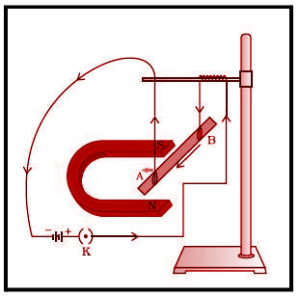
If we hold the thumb, forefinger, and central finger of the left-hand perpendicular to each other and the forefinger points in the direction of the magnetic field and the central finger in the direction of the current, the thumb points in the direction of motion (or force) on the conductor, according to this rule.

Current is induced in a conductor when it is placed in a magnetic field. Fleming’s right-Hand Rule determines the direction of induced current. It’s used to figure out which way the current in a generator is flowing.
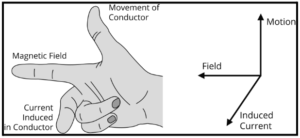
Force on a current-carrying conductor in a uniform magnetic field
When a conductor is carrying current and is placed in a magnetic field, the conductor feels a magnetic force. This acting force is always perpendicular to the plane containing both the magnetic field and the conductor.
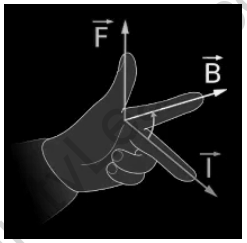
In the diagram above, F represents force, B represents the magnetic field, and I represents current. Some factors influence the magnetic force on the current-carrying conductor in a magnetic field. These factors include the length of the wire, the current flowing through it, and the strength of the magnetic field.
The conductor contains a large number of electrons, and the current in the conductor represents the drifting of free electrons in any of the fixed directions, as each electron experiences the magnetic force caused by free-electron motion. As a result, the conductor feels the magnetic force as well.
Consider a conductor with length l and cross-sectional area A that is placed in a uniform magnetic field. If n denotes the number of electrons present per unit volume and Vd denotes the drift velocity of electrons with the electronic charge e, then the current in the conductor can be represented as follows.
I=nevdA
Each electron experiences the Lorentz magnetic force as a result of the movement of electrons in the magnetic field.
Fe =evdB
=e v d B sinθnˆ
The total current on the conductor is depicted below.
N=nAl
The conductor is subjected to the following total force.
F=NFe
=n Ale v d B sinθnˆ
=nevdAlBuminθnˆ
=IlBsinθnˆ
F=I(l×B)
Characteristics Of Magnetic Field:
Magnetic field lines have the following properties:
- The magnetic field direction at any point is given by the tangent to the field lines at that point.
- Magnetic field lines never intersect.
- The magnetic field intensity at any point in space is given by the density of the magnetic field lines.
- Magnetic field lines are always close and continuous; they have no beginning and end.
- At any point on the field, field lines have both direction and magnitude. Magnetic field lines are thus represented by a vector.
- They indicate the magnetic field’s direction.
- Because the field lines are denser near the poles, the magnetic field is stronger there.
Magnetic Field:
A magnetic field is a field created by moving magnets or electric charges. The magnetic field is the region of space where the force of magnetism acts on a magnetic material or a moving electric charge. Magnetic field lines are used to represent magnetic fields. It is a visual tool for determining the direction and strength of a magnetic field.
The magnetic field is the area around a magnetic material or a moving electric charge where the force of magnetism acts. A magnetic field is a vector field in which magnetic forces can be measured in the presence of a magnet, an electric current, or a changing electric field. Moving electric charges and intrinsic magnetic moments of elementary particles associated with a fundamental quantum property known as spin generate a magnetic field. Magnetic and electric fields are both interconnected and components of the electromagnetic force, one of nature’s four fundamental forces.
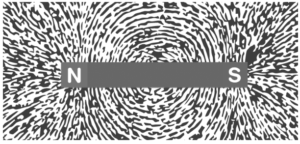
The magnetic field strength can also be referred to as magnetic field intensity or magnetic intensity. It is denoted as vector H and is defined as the ratio of the MMF required to generate a specific Flux Density (B) within a given material per unit length of that material. The strength of a magnetic field is measured in amperes per metre.
Magnetic field due to current-carrying wire
Ampere proposed that when an electrical charge moves, a magnetic field is created. Consider a wire through which current is made to flow by connecting it to a battery for clarity. As the current through the conductor increases, so does the magnetic field. The magnetic field decreases with distance as we move away from the wire. This is described by Ampere’s law.
The equation gives the magnetic field at a distance r from a long current-carrying conductor I, according to the law.
B=µ0I/2πr
In the equation, µ0 represents the permeability of free space, which is a special constant.
µ0=4p×10-7T·m/A
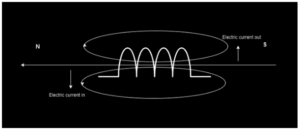
Magnetic fields can be concentrated in materials with higher permeability. Because the magnetic field is a vector quantity, it has a direction. The right-hand rule can be used to calculate the conventional current flowing through a straight wire. To apply this rule, imagine wrapping your right hand around the wire with your thumb pointing in the current direction. The magnetic field that wraps around the wire is depicted by the fingers.
Frequently Asked Questions (FAQs):
What is the source of the Earth's magnetic field?
The magnetic field of the Earth is created deep within the Earth's core. The flow of liquid iron at the Earth's core generates an electric current, which generates magnetic fields. Charged metals passing through these fields generate their own electric currents, and the cycle continues. The geodynamo is the name given to this self-sustaining loop. The Coriolis force causes spiralling, which aligns separate magnetic fields in the same direction. The combined effect of magnetic fields creates a massive magnetic field that engulfs the planet.
What exactly is a magnetic field?
The magnetic field is the area around a magnetic material or a moving electric charge where the force of magnetism acts.
Determine the magnetic flux density.
Magnetic flux density is the amount of magnetic flux in a given area measured perpendicular to the direction of the magnetic flux. It is denoted by the symbol B and is measured in Tesla units.









